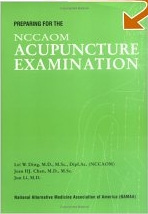Acupuncture and TCM Books
Preparing for the NCCAOM Acupuncture Examination
 Preparing for the NCCAOM Acupuncture Examination
Preparing for the NCCAOM Acupuncture Examination
Check New and Used Prices
by Lei Ding
National Certification Commission for Acupuncture and Oriental Medicine (NCCAOM) is the national organization which issues “National Board of Certification in Acupuncture’ and the “National Board Certification in Chinese Herbology’. NCCAOM Certification in Acupuncture has been widely recognized by many states and required for the acupuncture licensure.
This book is written to help the applicants to prepare and self-assess for the NCCAOM certification examination. However, those preparing for other standardized acupuncture examinations may also find this book useful.
This book includes 1000 multiple-choice questions with answers. The topics covered reflect the content outline of the NCCAOM examination. The questions follow the format used on the NCCAOM examination.
Table of Contents
Test 1
Test 2
Test 3
Test 4
Test 5
Answers for Test 1
Answers for Test 2
Answers for Test 3
Answers for Test 4
Answers for Test 5
Appendix 1. The Five Phase Chart
Appendix 2. Zhang (Yin Organs) Channel and point Chart
Appendix 3. Fu (Yang Organs) Channel and point Chart
Appendix 4. The Four Needle Technique
Appendix 5. The Entry and Exit Point of Twelve Channels
Appendix 6. The Window of Sky points
Appendix 7. The Influent Points
Appendix 8. Categories of Acupuncture Points
Appendix 9. Forbidden Points
Appendix 10. References
SAMPLE QUESTIONS
1. Which of the following meridians reaches the lower abdomen and genital organs?
(1) Kidney
(2) Urinary bladder
(3) Liver
(4) Gall bladder
2. Which of the following points are at the same level?
(1) Du 6 (Jizhong), UB 20(Pishu), UB 49 (Yishe)
(2) Du 6 (Jizhong), UB 21 (Weishu), UB 50 (Weicang)
(3) Du 7 (Zhongshu), UB 20 (Pishu), UB 49 (Yishe)
(4) Du 7 (Zhongshu), UB 19 (Danshu), UB 48 (Yanggang)
3. After you have made a diagnosis of excess of gall bladder, which of the following is the best choice for treatment according to the 4 needle technique?
(1) Tonifying GB 38 (Yangfu) and SI 5 (Yanggu), sedating GB 44 (Qiaoyin) and LI 1(Shangyang)
(2) Tonifying GB 43 (Xiaxi) and UB 66 (Zhiyin), sedating GB 44 (Qiaoyin) and LI 1 (Shangyang)
(3) Tonifying GB 43 (Xiaxi) and UB 66 (Zhiyin), sedating GB 38 (Yangfu) and SI 5 (Yanggu)
(4) Tonifying GB 44 (Qiaoyin) and LI 1 (Shangyang), sedating GB 38 (Yangfu) and SI 5 (Yanggu)
4. Which of the following is the best choice for the treatment of the superficial syndrome caused by external wind heat?
(1) LI 4 (Hegu), GB 20 (Fengchi), Liv 2 (Xingjina), Ext 29(Sifeng)
(2) Lu 7 (Tayuan), B 12 (Gengmen), LI 4 (Hegu), G 20 (Fengchi)
(3) Lu 10 (Yuji), Du 14 (Dazhui), LI 11(Shaoshang), LI 4 (Hegu)
(4) Du 16 (Fengfu), L 1 (Shangyang), L 7 (Lieque), Ren 8 (Shenjue)
5. After his wife´s death, a man remains depressed without recovery. The disorder most likely involves which of the following organs?
(1) Liver
(2) Lung
(3) Spleen
(4) Kidney
QUESTIONS 6 TO 8 REFER TO THE FOLLOWING INFORMATION:
A 26 year old teacher becomes easily angered and is recently depressed. She complains of chest tightness and dysmenorrhea. She also often wakes up at 11 PM and can not fall asleep until 3 AM. Her tongue coat is thin and white.
6. According to the Horary (midday/midnight) cycle theory, which of the following organs may have a problem?
(1) Liver
(2) Heart
(3) Spleen
(4) Kidney
7. The most likely cause is
(1) Qi deficiency
(2) Qi stagnation
(3) blood deficiency
(4) blood stagnation
8. The most suitable points to select are
(1) UB 23 (Shenshu), Du 4 (Mingmen), Liv 3 (Taichong), UB 15 (Xinshu)
(2) UB 21 (Weishu), UB 29 (Zhonglushu), Liv 3 (Taichong), St 3 (Juliao)
(3) GB 34 (Yanglingquan), Liv 14 (Qimen), Liv 3 (Taichong), SJ 6 (zhigou)
(4) Ren 6 (Qihai), Du 14 (Dazhui), Liv 3 (Taichong)
END OF THE CASE
9. When you needle Ren 23 (Lianquan), the right way is to
(1) insert needle 0.5 cun straight
(2) insert needle 0.5-1.0 cun in the direction of the tip of the tongue
(3) insert needle 0.5-1.0 cun in the direction of the root of the tongue
(4) insert needle 0.5-1.0 cun to the sides of the tongue
10. Which of the following points is not for needle treatment?
(1) Ren 7 (Yinjiao)
(2) Ren 6 (Qihai)
(3) St 17 (Rouzhong)
(4) Du 1 (Changqiang)
11. Which of the following is the best choice for sedating liver Qi attacking the stomach?
(1) St 36 (Zusanli), St 40 (Fenglong), St 44 (Lidui), Ext 29 (sifeng)
(2) St 36 (Zusanli), Sp 4 (Gongsun), Liv 3 (Taichong), P 6 (Neiguan)
(3) UB 20 (Pishu), St 36 (Zusanli), St 40 (Fenglong), GB 34 (Yanglingquan)
(4) UB 20 (Pishu), UB 21 (Weishu), UB 23 (Shenshu), St 25 (Tianshu)
12. The genitals are the opening of
(1) spleen
(2) heart
(3) kidney
(4) lung
13. According to Horary (midday/midnight) cycle theory, at acertain time, the Qi will go through which of the following points in order to flow in meridians?
(1) Well (Jing) and Stream (Shu) points
(2) Entry and Exit points
(3) Spring (Ying) and River (Jing) points
(4) Source (Yuan) and Ho (He-sea) points
14. The kidney meridian passes along
(1) the posterior and medial side of the leg
(2) the anterior and medial side of the leg
(3) the posterior and lateral side of the leg
(4) the anterior and lateral side of the leg

Preparing for the NCCAOM Acupuncture Examination
Check New and Used Prices